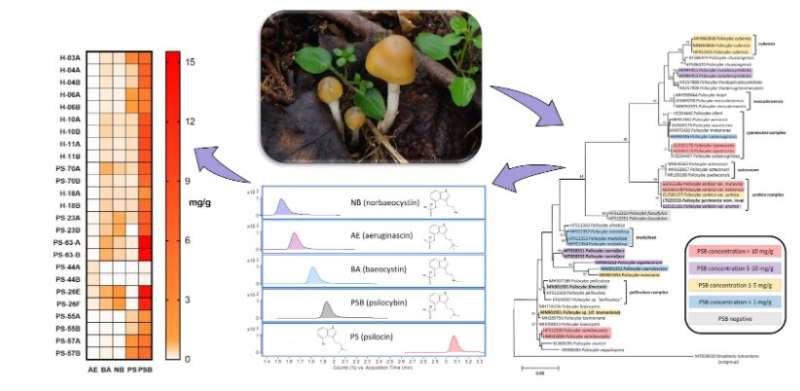Concentrations of psychoactive compounds in mushrooms found to be extremely variable

Since not only psilocybin (PSB) but also PSB-containing mushrooms are used for psychedelic therapy and microdosing, it is necessary to know their concentration variability in wild-grown mushrooms. Research, now published in the International Journal of Molecular Sciences, aimed to determine the PSB, psilocin (PS), baeocystin (BA), norbaeocystin (NB), and aeruginascin (AE) concentrations in a large sample set of mushrooms belonging to genera previously reported to contain psychotropic tryptamines.
Psychotropic mushrooms are mushrooms that contain compounds that can have a psychoactive effect on the brain, causing changes in perception, mood, and consciousness. These mushrooms are often used for their hallucinogenic properties, and they have been used for centuries in traditional spiritual and medicinal practices. Some of the most well-known psychotropic mushrooms are species of the genera Psilocybe, Conocybe, and Panaeolus.
Nevertheless, Fungi are an understudied, biotechnologically valuable group of organisms. Numerous biologically active compounds (secondary metabolites) have been described from mushrooms (macromycetes), and among them, psychotropic tryptamines have played fascinating roles in both ancient and modern human history. The main fungal tryptamines are psilocybin (PSB) and psilocin (PS), while the minor tryptamines are baeocystin (BA), norbaeocystin (NB), and aeruginascin (AE).
However, the psychotropic effect of BA, NB, and AE has not been fully established. It has been reported that the same dose of BA administered produced a psychotropic effect as the same dose of PSB. However, BA and NB may not be psychoactive per se, but they can be transformed by PsiK kinase and PsiM methyltransferase to PS, which is psychotropic.
In their study, "Extensive Collection of Psychotropic Mushrooms with the Determination of Their Tryptamine Alkaloids," researchers used ultra-high-performance liquid chromatography coupled with tandem mass spectrometry to quantify tryptamine alkaloids in the mushroom samples.
Concentrations of five tryptamine alkaloids were determined in a large sample set of 226 fruiting bodies of 82 individual collections from seven mushroom genera. For many mushroom species, concentrations of BA, NB, and AE are reported for the first time.
The highest PSB/PS concentrations were found in Psilocybe species, but no tryptamines were detected in the P. fuscofulva and P. fimetaria collections. Therefore, "the tryptamine concentrations in mushrooms are extremely variable, representing a problem for mushroom consumers due to the apparent risk of overdose. The varied cocktail of tryptamines in wild mushrooms could influence the medicinal effect compared to therapy with chemically pure PSB, posing a serious problem for data interpretation," said principal researcher Martin Kuchař from the Department of Chemistry of Natural Compounds, University of Chemistry and Technology Prague.
More information: Klára Gotvaldová et al, Extensive Collection of Psychotropic Mushrooms with Determination of Their Tryptamine Alkaloids, International Journal of Molecular Sciences (2022). DOI: 10.3390/ijms232214068
Provided by University of Chemistry and Technology Prague




















